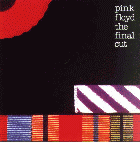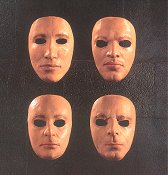


Tear Down The Wall
 Pink Floyd have been around for ages. And, unrestrained by a rampant combination of yes-men, money, recreational substances, and egos, they've had some absolutely appalling ideas. Ideas to which any sensible person would say "You've Got To Be Crazy". Ideas that only the Floyds themselves would take seriously enough to execute in front of millions, or at least to consider executing, if they weren't too expensive. And when something's too expensive for the Floyd, then it's just too darn expensive for anyone.
Pink Floyd have been around for ages. And, unrestrained by a rampant combination of yes-men, money, recreational substances, and egos, they've had some absolutely appalling ideas. Ideas to which any sensible person would say "You've Got To Be Crazy". Ideas that only the Floyds themselves would take seriously enough to execute in front of millions, or at least to consider executing, if they weren't too expensive. And when something's too expensive for the Floyd, then it's just too darn expensive for anyone.
But there was one great Floydian disaster that went on and on and on, unchecked by costs or the fact that it almost tore the band apart. That disaster was The Wall.
I know that this is an unpopular opinion. A lot of people love The Wall. In fact, as far as I can work out everyone in the world is forced by law to buy a copy of The Wall and The Dark Side of the Moon the moment he becomes aware of music. I once found a copy of The Wall on cassette at my Grandma's house. That's my Grandma, who was born in 1919, and seemingly bought it at the grand old age of (at least) 60.
I never asked her about that. Maybe it was the songs about Vera Lynn that she liked.
But The Wall? Let's just look at this. A 30-something multimillionaire producing about 100 minutes of songs wrapped up in some bizarre narrative, trying to equate the decline of a stupid, immature rock star's descent into madness with abandonment issues because the Germans killed his daddy at Anzio. Now, it wouldn't take a genius to work out that it is at least in some way autobiographical. And that's before Roger wrote the screenplay and kept using the word "Roger" instead of "Pink".
The Album
 Was The Wall the Floyd's greatest disaster? |
So lets look at The Wall in its many, many guises. First is the album. 81 minutes of torture courtesy of Mr. Waters, almost exclusively written by Mr. Tuneless himself, with help on a couple of songs from a guitarist that he clearly didn't like. Sure. That's not a problem, until we get to side three, and a torrent of songs about Vera Lynn, bringing the boys back home (pointlessly re-recorded to neligable effect for a single release B-side), and The War. In fact, there are at least eleven songs on the album that would be better off as B-sides: eleven pointless, midpaced dirges of Roger exorcising his neurotic demons that seem lacking in any memorable features (such as guitars, drums, or in fact, on at least one song, any member of Pink Floyd).
The dirty near-dozen? "One of My Turns", "Don't Leave Me Now", "Is There Anybody Out There?", "Nobody Home", "Vera", "Bring The Boys Back Home", "The Show Must Go On", "Waiting for the Worms", "Stop", "The Trial", and, if I'm not in the right frame of mind, "In the Flesh" (which appears twice, sort of).
On top of this, a last minute re-editing of The Wall (thankfully) reduced Roger's Wall from a triple album to a double. Unfortunately, this meant that King Rog decided to cut down some of the album's best songs (slicing "Empty Spaces" in half, completely removing "What Shall We Do Now?", and truncating "Young Lust" to a fraction of it's former length). And they did this after they'd printed the sleeves, so owners of early vinyl editions will find that the tracklisting on the cover differs somewhat radically from the record they were listening to.
Now, some could say that side one of The Wall (20:22), and side two (in it's edited form, 18:50) needed to be trimmed in order to fit into the optimum capacity for a vinyl recording. But with those three songs restored, side two of the album would have come to 22:10 (based on the film soundtrack)... surely not too long for a vinyl LP? And, incidentally, only 27 seconds longer than side four of the album.
All things considered, The Wall would have made a fantastic single album, a painful double album, and an absolutely dreadful triple album. Anyone who has heard The Clash's Sandinista will know that that record is 110 minutes too long.
The Concert
Still, Rog was never one to be put off. The Wall was later to appear in another five or six guises. Rog's next great idea was for the band to perform the whole of the album live, but behind a polysterene wall. Naturally, this eventually resulted in 2000's Is There Anybody Out There? live record, which gave us at least two songs that didn't make the final cut--the aforementioned "What Shall We Do Now?" and a fabulous instrumental piece called "The Last Few Bricks".
But there's more. The stage show that the band performed in just four cities saw them cocooned behind a big fat wall, surrounded by teacher-shaped ballons that didn't quite work, and generally disappearing up their own bums. Great idea: play the biggest venues in the world, build a big Lego wall in front of the stage, and get the crowd to watch cartoons. Yowsa. And Rog still thinks that this is maybe the greatest idea he ever had.
The Film
 One of several Wall-inspired maquettes that were made available in 2003. |
Then there was the film: Rog's story mixed up with Syd's, some highly confused self-aggrandising tale of Rock Star excess, self-pitying, and general stupidity that was lacking in narrative and painful to watch. Especially when that enormous talking bum farted out words for the prosecution. That talking bum, incidentally, was turned into an action figure some 24 years later by Rog desperate to milk his neurosis for a last gasp of cash. In a momentary lapse of reason, I actually toyed with buying it.
A fourth incarnation of The Wall was the film's soundtrack, though it was never released independently. For this, the band, now shorn of long time keyboardist Rick Wright (who was replaced by a whole orchestra), re-recorded and remixed at least seven songs, and one new song that was excised neatly from the upcoming Final Cut album.
Enter all-new previously unheard versions of "When The Tigers Broke Free", "In the Flesh", "Empty Spaces", "What Shall We Do Now", "Young Lust", "Mother", "Bring The Boys Back Home", and "Outside The Wall". The band also wrote an overture, a previously unreleased piece that acted as a score for the film, but ultimately wasn't used. Have I used the phrase 'overkill' yet?
Originally these recordings were meant to be released as a soundtrack album--Spare Bricks--alongside songs that were trimmed at the last minute from the triple-album version of The Wall. This was quickly cancelled in favour of a single of re-recordings ("When The Tigers Broke Free" backed with "Bring The Boys Back Home") and an album of reheated, re-recorded leftovers from The Wall and a couple of new songs that were later released as The Final Cut. According to Gilmour, the songs weren't good enough to go in The Wall, so quite why Rog decided they deserved a separate release is a mystery to most everyone. Including some of the people in the band.
The Final Cut
 The Final Cut was not, despite the title, the final retread of The Wall. |
The Final Cut was for many the final straw. Emblazoned with a picture of a military officer (presumably his father) holding a can of film reel (presumably the original, pure vision of Rog's indulgence instead of the allegedly butchered finished motion picture), The Final Cut is Rog's first solo album in all but name. The Floyd were in tatters and the whole album is credited as "a requiem for the post war dream by Roger Waters and performed by Pink Floyd". Utter, utter madness.
There wasn't even a 'Pink Floyd' anymore. By this time, Rog had sacked Richard Wright, Michael Kamen was playing all the keyboards, Dave Gilmour sang half of one song, Nick Mason didn't bother to play on the last song, and the first note of music actually played by a member of Pink Floyd came in the third song. David Gilmour was so frustrated by the finished product he took his name off the production credits in disgust--but pocketed his share of the production royalties.
Immediately after finishing The Final Cut, mad Rog took everyone who worked on it (bar the members of Pink Floyd) to the same studio a month later, hired Eric Clapton to run off some Floyd riffs, and made The Pros And Cons of Hitch Hiking, an album the Floyd had refused to record five years earlier as they didn't think it was... erm... very interesting. And they were right.
The Wall live in Berlin
 The Wall's pig, as seen in the 1990 Berlin performance. |
Rog still wasn't finished with The Wall. For it's fifth and a half (for now) incarnation there came The Wall In Berlin. In this final indignity, Rog performed in front of a giant plastic wall to 300,000 pissed up Germans, blew the power, sold the TV rights at the last minute for peanuts, got in guest stars who kept getting their words wrong, and had the sheer brass balls to make a gigantic wall on the site where the Berlin Wall once was, crowed about how Hitler killed his Daddy, and indulge his despot fantasies. Truly dreadful (even if Snowy White's solo in "Empty Spaces" is fantastic).
Before the gig, Rog went back into the studio, re-recorded several of the songs from the album, and released a dreadful "Potsdamer Disco Mix" of "Run Like Hell". In this particular form, the Floyd's most neurotic number jiggled much like the Scissor Sisters and was the artistic equivalent of Dali putting smiley faces all over his "Guernica". Utter blasphemy.
Is There Anybody Out There? The Wall Live
 Is There Anybody Out There? was a long-awaited official document of the Wall performances. |
There's one last thing. In 2000, the Floyd released their own live version of The Wall. Brutally edited from at least five shows that were originally filmed for home video release, Is There Anybody Out There? was a fantastic live record. Sure, it was too long, but it had been mixed to within an inch of its life, came in a 10" x 6" hardback book and generally had even more overkill than a Motorhead album. But it was much better than any previous version of The Wall even if it was twenty years too late.
From here, there isn't much more anyone can do to exploit The Wall legacy. Apart from the aforementioned action figures (or 'maquettes' as they are poshly known), there are a range of garish workshirts for you to treasure, with printed reproductions of Gerald Scarfe styrofoam bricks.
I really, really wish I were making that last bit up.
Outside The Wall
The reissues haven't stopped. The original film has now been released on DVD with a commentary, deleted scenes, and documentaries galore, and the original double album has been re-released on CD in fancy boxes. TV documentaries turn up regularly, and there are always rumours of the long awaited concert footage originally shot for the film being restored and released on DVD. No doubt a 25th anniversary issue is imminent, which may see a complete remastering of the album, alongside the restoration of all those pesky deleted songs in some kind of bloated FatElvis-style reappraisal. It's all the rage. Money from Misery.
By now, I think its fair to say that, despite its massive commercial success, artistically The Wall is an enormous conceit: an artschool project of a grown man exorcising his demons on an obscene scale, endlessly repeating the same motifs and musical ideas, painting some rose-tinted picture of childhood tainted by war, death, and demon headmasters straight out of children's storybooks. There is endless whinging about how dreadful it is being surrounded by sex, money, and drugs, and playacting an ill-thought undergraduate drama school project. Rog think it may very well be the Best Thing He's Ever Done, but he's in a Minority Of One there.
Let him battle his own neurosis and insult his audience with the whiny driveling about how being rich, famous, sexy, and talented is even worse than working in a factory. In the meantime...
Tear down The Wall.